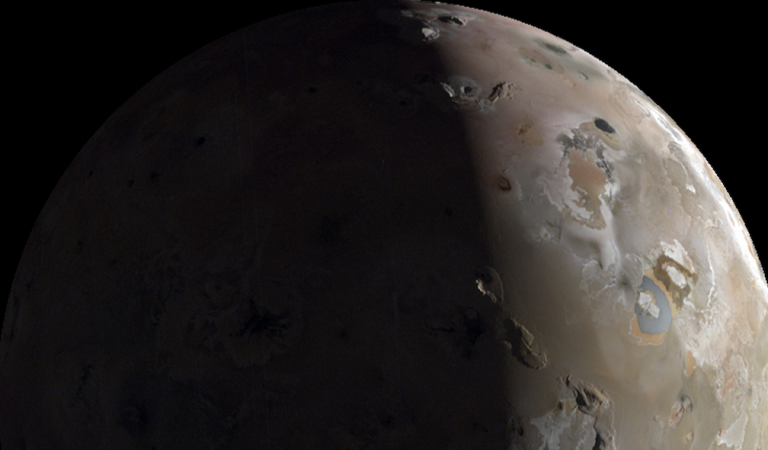
Behold the volcano-blanketed moon, Io.
After swooping by Jupiter’s tortured moon on Feb. 3, NASA‘s Juno spacecraft beamed back some of the closest-ever images of this unique world. The agency’s deep space probe came within just 930 miles (1,500 kilometers) of Io, following a similar pass just over a month ago. Planetary scientists hope these much-anticipated flybys will answer fundamental questions about the mysterious, lava-spewing moon.
“The twin flybys are designed to provide new insight into how Io’s volcanic engine works and whether a global magma ocean exists under Io’s rocky, mountainous surface terrain,” mission operators wrote after the first images came back.
Io contains hundreds of volcanoes, many of which are active and hot enough for Juno to detect their heat on the moon’s surface. Some of the prominent mound-like volcanoes are easily visible in the images below, as are darker areas where lava may have somewhat recently flowed.
These impressive views are processed (removing noise and distortion, etc.) by both professional and amateur image processors, some of whom work for NASA or related space research programs. These are the closest views of Io captured in over two decades. (More images will be added as they become available.)

Credit: NASA / JPL-Caltech / SwRI / MSSS

Credit: NASA / JPL-Caltech / SwRI / MSSS / AndreaLuck / CC BY 3.0 Unported
Io is blanketed in erupting volcanoes because it’s relentlessly locked in a tug-of-war between nearby objects, including the colossal Jupiter. “Not only is the biggest planet in the solar system forever pulling at it gravitationally, but so are Io’s Galilean siblings — Europa and the biggest moon in the solar system, Ganymede,” NASA explained in a statement. “The result is that Io is continuously stretched and squeezed, actions linked to the creation of the lava seen erupting from its many volcanoes.”
In recent months, the Juno craft has spotted clear signs of activity on Io, including a hazy plume it observed over the volcano Prometheus. NASA’s Galileo mission also captured a plume above these fields of lava in the year 2000.
“It is the purest form of discovery.”
Planetary scientists will pour over these latest images in the coming weeks, months, and years. The new views and data could reveal whether or not a lava ocean sloshes beneath Io’s hardened lava crust.
“It is the purest form of discovery,” Ashley Davies, a planetary scientist at NASA’s Jet Propulsion Laboratory who researches Io, told Mashable in November 2023. “We’re seeing things that we have never seen before.”
This story was updated with more new images of the Jovian moon Io.



















0 Comments